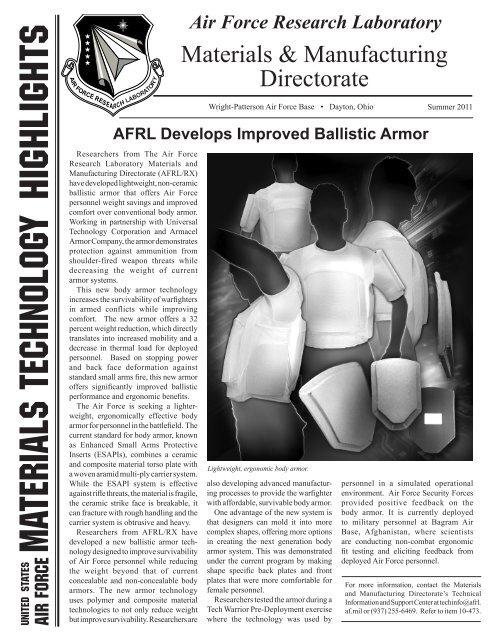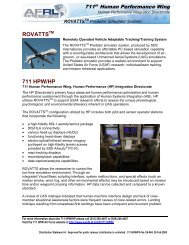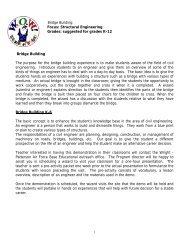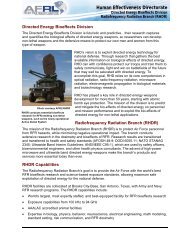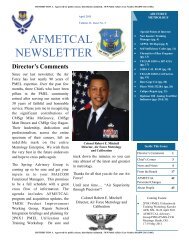AFRL Develops Improved Ballistic Armor - Wright-Patterson Air ...
AFRL Develops Improved Ballistic Armor - Wright-Patterson Air ...
AFRL Develops Improved Ballistic Armor - Wright-Patterson Air ...
Create successful ePaper yourself
Turn your PDF publications into a flip-book with our unique Google optimized e-Paper software.
UNITED STATESMATERIALS TECHNOLOGY HIGHLIGHTSAIR FORCE<strong>Air</strong> Force Research LaboratoryMaterials & ManufacturingDirectorate<strong>Wright</strong>-<strong>Patterson</strong> <strong>Air</strong> Force Base • Dayton, Ohio<strong>AFRL</strong> <strong>Develops</strong> <strong>Improved</strong> <strong>Ballistic</strong> <strong>Armor</strong>Researchers from The <strong>Air</strong> ForceResearch Laboratory Materials andManufacturing Directorate (<strong>AFRL</strong>/RX)have developed lightweight, non-ceramicballistic armor that offers <strong>Air</strong> Forcepersonnel weight savings and improvedcomfort over conventional body armor.Working in partnership with UniversalTechnology Corporation and Armacel<strong>Armor</strong> Company, the armor demonstratesprotection against ammunition fromshoulder-fired weapon threats whiledecreasing the weight of currentarmor systems.This new body armor technologyincreases the survivability of warfightersin armed conflicts while improvingcomfort. The new armor offers a 32percent weight reduction, which directlytranslates into increased mobility and adecrease in thermal load for deployedpersonnel. Based on stopping powerand back face deformation againststandard small arms fire, this new armoroffers significantly improved ballisticperformance and ergonomic benefits.The <strong>Air</strong> Force is seeking a lighterweight,ergonomically effective bodyarmor for personnel in the battlefield. Thecurrent standard for body armor, knownas Enhanced Small Arms ProtectiveInserts (ESAPIs), combines a ceramicand composite material torso plate witha woven aramid multi-ply carrier system.While the ESAPI system is effectiveagainst rifle threats, the material is fragile,the ceramic strike face is breakable, itcan fracture with rough handling and thecarrier system is obtrusive and heavy.Researchers from <strong>AFRL</strong>/RX havedeveloped a new ballistic armor technologydesigned to improve survivabilityof <strong>Air</strong> Force personnel while reducingthe weight beyond that of currentconcealable and non-concealable bodyarmors. The new armor technologyuses polymer and composite materialtechnologies to not only reduce weightbut improve survivability. Researchers areLightweight, ergonomic body armor.also developing advanced manufacturingprocesses to provide the warfighterwith affordable, survivable body armor.One advantage of the new system isthat designers can mold it into morecomplex shapes, offering more optionsin creating the next generation bodyarmor system. This was demonstratedunder the current program by makingshape specific back plates and frontplates that were more comfortable forfemale personnel.Researchers tested the armor during aTech Warrior Pre-Deployment exercisewhere the technology was used bySummer 2011personnel in a simulated operationalenvironment. <strong>Air</strong> Force Security Forcesprovided positive feedback on thebody armor. It is currently deployedto military personnel at Bagram <strong>Air</strong>Base, Afghanistan, where scientistsare conducting non-combat ergonomicfit testing and eliciting feedback fromdeployed <strong>Air</strong> Force personnel.For more information, contact the Materialsand Manufacturing Directorate’s TechnicalInformation and Support Center at techinfo@afrl.af.mil or (937) 255-6469. Refer to item 10-473.
Page 2USAF MATERIALS TECHNOLOGY HIGHLIGHTSGraphene Research Leads to Advances in Carbon-Based ElectronicsGraphene research performed by the <strong>Air</strong>Force Research Laboratory Materials andManufacturing Directorate (<strong>AFRL</strong>/RX) hasmade a significant contribution to materialsdevelopment of carbon-based electronics.These efforts improved the understandingof the growth process for both grapheneand carbon nanotubes (CNTs) on siliconcarbide (SiC).Researchers predict that graphene willbe as transformative to coming generationsas the television, atomic bomb, and siliconchip. It has enormous potential to impact<strong>Air</strong> Force capabilities such as enabling bandhopping radar, and leading to radio frequencysemiconductors that are 100 times faster thanthe current state-of-the-art. Graphene maylead to the production of lighter aircraft andsatellites, and may be used in sensors, electricbatteries, transparent conductive coatings forsolar cells, and in a variety of other applications.Graphene is a recently discovered form ofcarbon, whose structure is a one-atom-thicksheet of carbon atoms. Graphene is most easilyvisualized as an atomic-scale chicken wiremade of carbon atoms at the crossing points andstrong covalent bonds connecting them. Thecrystalline or "flake" form, graphite, consists ofmany graphene sheets weakly stacked together.A stack of three million graphene sheets wouldbe only one millimeter thick. Graphene exhibitsthe highest conductivity and other intriguingproperties and has been widely popularized asthe successor to silicon.Unmanned Ground Vehicle Successfully DemonstratedA team from the <strong>Air</strong> Force ResearchLaboratory Materials and ManufacturingDirectorate (<strong>AFRL</strong>/RX) participated ina successful demonstration of unmannedair and ground robotics, and demonstratedcommand and control collaborative integrateddefense practices at Vandenberg AFB,Calif. The demonstration validated the useof the Immediate Visual Assessment andNeutralization (IVAN) unmanned groundvehicle for perimeter security.Several <strong>AFRL</strong> systems, including theIVAN ground vehicle, developed by theRobotics Research Group at <strong>AFRL</strong>’s <strong>Air</strong>baseTechnologies Division, Tyndall AFB,Fla., successfully performed during thedemonstration. The Human Effectiveness(RH) and <strong>Air</strong> Vehicles (RB) Directorates alsodemonstrated their Vigilant Spirit ControlSoftware and the Bat 3 and Unicorn unmannedair vehicles.RX researchers improved the understandingof the graphene growth process on SiC anddemonstrated the important catalytic role ofoxygen in this process. They enabled metalfree growth of both CNTs and graphene onSiC substrates, improving the purity by anorder of magnitude and enhancing the qualityof in-house grown graphene.RX researchers developed a graphenegrowth process and a complementary CNTgrowth process to grow 0.5 micrometerthick CNT carpets. They developed anddemonstrated improved characterizationtechniques and traveled to Manchester,England, to work with the 2010 Nobellaureates in Physics. The Nobel Prize inPhysics was awarded to Dr. Andre Geim andDr. Konstantin Novoselov for groundbreakingexperiments regarding graphene. As part ofthis collaboration, RX researchers transferredtheir Electron Beam Induced Currentexpertise and equipment to the Universityof Manchester, to further internationalcollaborative graphene research.Researchers at Columbia University's FuFoundation School of Engineering provedthat graphene is the strongest material evermeasured. It’s also the thinnest possiblematerial that is feasible, it’s about 200 timesstronger than steel, and it conducts electricitybetter than any material known to man – atroom temperature.During the demonstration, personnel fromRX, as well as engineers from RH and RB,showcased their unmanned technologies,which successfully performed in the simulatedmission environment. The demonstrationincluded unmanned air vehicles, an unmannedground vehicle, a ground control station andcontrol and decision algorithms that allowed anoperator to manage activities. The integrationwas seamless and showed the synergisticcapabilities provided by combining theunmanned assets and using the informationthey gather to accomplish tasks.The <strong>Air</strong>base Technologies Division(RXQ) is the <strong>Air</strong> Force's lead organization forairbase technology research and development.RXQ provides science, technology, andengineering to advance fixed and deployedairbase capabilities in Force Protection,Infrastructure, and Homeland Security. Thedivision provides technologies that enableThe development of graphene transistors(to replace silicon) may result in faster speedsand improvements in computer chips. Otherpotential applications include replacementof carbon fibers in composite materials,high-power high-frequency electronicdevices, stronger medical implants and bettersports equipment.For more information, contact the Materialsand Manufacturing Directorate’s TechnicalInformation and Support Center at techinfo@afrl.af.mil or (937) 255-6469. Refer to item 11-066.A transmission electron micrograph (TEM) of agraphene film grown by RX researchers with fourlayers of graphene. TEM samples were preparedusing a focused ion beam lift out technique inwhich a platinum layer is deposited on the surfacefor protection.nonstop <strong>Air</strong> Force readiness, peacetimetraining, and rapid deployment missions andoperations.IVAN is a small, multi-role unmannedground vehicle, with the capability to integrateboth lethal and non-lethal payloads in supportof missions. IVAN can perform the repetitiveand dangerous tasks of protecting criticalassets, performing routine patrols, andresponding to, investigating and neutralizingthreats to critical resources.For more information, contact the Materialsand Manufacturing Directorate’s TechnicalInformation and Support Center at techinfo@afrl.af.mil or (937) 255-6469. Refer to item 10-370.
USAF MATERIALS TECHNOLOGY HIGHLIGHTS Page 3Lightweight Ammunition Program Yields Promising ResultsA team from the <strong>Air</strong> Force ResearchLaboratory Materials and ManufacturingDirectorate, the US Marine Corps, and MAC,LLC, is working to establish a domesticproduction capability for the manufacture oflightweight ammunition. If successful, theproject will yield military grade ammunitioncasings made with high performance polymericmaterials that offer significant ammunitionweight reduction without compromisingweapon system effectiveness.If this promising Defense ProductionAct Title III program successfully reachescompletion, it will result in a fully automatedproduction line establishing a multimillionunit capacity to manufacture lightweightammunition. Weight-reducing technologieswill allow the warfighter to carry largeramounts of ammunition and give themimproved battlefield mobility and survivability.Weight reductions also decrease the logisticalfootprint and allow for larger quantities ofammunition to be delivered without increasingshipment costs. Other potential benefits mayinclude improved accuracy, prolonged weaponlife, and lower cost.Ammunition, specifically cartridge cases,account for a large portion of the overallweight the modern warfighter must carry. Inmany instances, ammunition being carriedcan far outweigh the related weapon system.Traditional ammunition cartridges are made ofheavy, metallic-based materials such as steel,copper, aluminum or brass and can account forup to 50 percent of the total overall weight ofthe ammunition package.Polymer materials offer a desirablesubstitute for traditional metals in theproduction of ammunition cartridges dueto the weight and corrosion properties theyoffer. It has taken decades of research betweengovernment and private industry to developand demonstrate polymer materials capable ofwithstanding the operational rigors demandedby a wide variety of high-powered militaryweapon systems. Though the ammunitionretains a metal base and extraction ring,the additional polymer materials selectedfor use in lightweight ammunition casingshave demonstrated exceptional mechanicalstrength, ductility, hardness and scratchresistance combined with good transparency50 caliber lightweight ammunition.and ballistic performance in preliminarytesting. Their amorphous nature assureseasy processibility and formability whileshowing considerable chemical resistanceand damage tolerance. Thermal stability andmelt processibility are key characteristicsrequired for ammunition casings. Thesematerials have also demonstrated exceptionalballistic performance.(continued on following page)Visit us at: www.wpafb.af.mil/<strong>AFRL</strong>
Page 4USAF MATERIALS TECHNOLOGY HIGHLIGHTS(continued from previous page)In order to achieve the program goalof developing a fully automated productionline with a multimillion unit capacity tomanufacture lightweight ammunition, MAChas been concentrating on several factorsincluding building construction, equipmentprocurement, installation, product testing anddesign. Building construction was completedand major manufacturing equipment hasbeen evaluated, purchased and installed.MAC has also begun producing prototypelightweight .50 caliber ammunition to betested and evaluated by the DoD as partof the qualification process. The productionline is now capable of producing onemillion rounds per year of lightweight .50caliber ammunition.In addition to production line installment,the team has performed live fire demonstrationsthat have resulted in favorable results. Designoptions are being evaluated in order tooptimize the product and consider additionalopportunities for weight savings.For more information, contact the Materialsand Manufacturing Directorate’s TechnicalInformation and Support Center at techinfo@afrl.af.mil or (937) 255-6469. Refer to item 10-135.The USAF Materials Technology Highlights is published quarterly to provide information on materials research and developmentactivities by <strong>Air</strong> Force Research Laboratory’s Materials & Manufacturing Directorate. For more information on subjects covered in“Highlights” or to be added to the “Highlights” mailing list, contact the Materials & Manufacturing Directorate Technology Informationand Support Center at (937) 255-6469 or e-mail at techinfo@afrl.af.mil. Approved for Public Release. 88ABW-2011-2719<strong>AFRL</strong>/RXOB-TISC BLDG. 6532977 HOBSON WAY, ROOM 413WRIGHT-PATTERSON AFB OH 45433-7734_______OFFICIAL BUSINESSUNITED STATESAIR FORCEMATERIALS TECHNOLOGY HIGHLIGHTS


